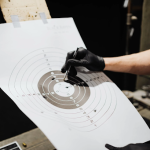
Importance of Selecting the Right Gunstock
Crafting a superior shooting experience starts with the foundational component of your firearm: the gunstock. The selection of the right gunstock is instrumental not only in determining the balance and feel of the gun but also in impacting your overall shooting performance. Comfort, accuracy, and the shooter’s confidence are intricately tied to this critical choice.
Impact of Gunstock on Shooting Performance
The gunstock you choose directly influences your control and handling of the firearm.
- Stability: A well-fitted stock provides a steady platform, enhancing accuracy.
- Recoil Management: The right stock can absorb recoil, reducing shooter fatigue and discomfort.
Understanding the Basics of Gunstocks
Definition and Function of a Gunstock
At its core, a gunstock, often simply called “stock,” is the part of a firearm to which the barrelled action and firing mechanism are attached. Its primary functions include:
- Providing structural support
- Allowing the shooter to comfortably hold and maneuver the firearm
- Absorbing recoil
Different Materials Used in Gunstock Construction
Gun stocks can be crafted from various materials, the choice of which affects the stock’s weight, durability, and aesthetic appeal. The most commonly used materials include:
- Wood: Walnut, maple, and birch
- Synthetics: Fiberglass, polymers, and composites
- Laminates: Layers of wood infused with plastic resin
Anatomy of a Gunstock
Each gunstock has several key components:
- Butt: The rear end, which rests against the shooter’s shoulder.
- Forend: The front part, where the shooting hand is placed.
- Cheek Piece: Where the shooter rests their cheek for aiming.
Types of Gunstocks
Traditional Wooden Stocks
Wooden stocks have been the standard for centuries due to their natural beauty and traditional feel.
- Pros: Aesthetic appeal, warmth to the touch, customizable
- Cons: Susceptible to weather, can warp or swell
Synthetic Stocks
Synthetic stocks are valued for their durability and resistance to environmental factors.
- Pros: Weather-resistant, more durable, often lighter
- Cons: Lack the traditional feel and look of wood
Laminate Stocks
Laminate stocks offer a middle ground, with improved durability and unique aesthetics.
- Pros: More stable than wood, wide range of colors and patterns
- Cons: Tend to be heavier, can be costly
Folding and Adjustable Stocks
These stocks are designed for versatility and ease of transport.
- Pros: Adjustable to fit various body types, compact for storage
- Cons: Can be less stable than fixed stocks, more mechanical parts
Factors to Consider When Choosing a Gunstock
Type of Firearm
Match the stock design to your specific firearm. For example:
- Bolt-action rifles often use different stocks than semi-automatic rifles.
- Shotguns designed for different purposes might favor specific stock characteristics.
Shooting Discipline (hunting, sport shooting, etc.)
Your shooting activity will dictate the ideal stock features:
- Hunting: Mobility might be key, thus a lighter stock is preferable.
- Sport Shooting: Stability might take precedence, favoring a heavier, more rigid stock.
Body Ergonomics and Comfort
- Every shooter’s body geometry is unique. Ensure the stock fits comfortably.
- Consider the stock’s length, grip size, and cheek piece configuration.
Weight Preferences
Choosing between Light vs. Heavy Rifle Stocks
- Heavier stocks can offer more stability but may be taxing during extended use.
- Lighter stocks improve maneuverability but might increase felt recoil.
The Role of Gunstock Fit
Importance of Proper Fit
Proper gunstock fit is crucial for an optimal shooting stance and can significantly improve your performance.
- A stock that’s too long or short can affect your aim and comfort.
- An improperly positioned cheek piece can hinder your line of sight.
How to Measure for Correct Gunstock Fit
To ensure the right fit, you should measure:
- Length of Pull: Distance from the trigger to the end of the stock.
- Comb Height: Proper alignment with the firearm’s sights or scope.
- Grip Size: Comfortable and secure hold without straining your hand.
Adjusting Stock for Custom Fit
There are ways to achieve a custom fit if the stock isn’t perfect off the shelf:
- Add or remove spacers to adjust the length of pull.
- Employ adjustable cheek pieces to tailor comb height.
- Consider professional fitting services for bespoke alterations.
Material Considerations
Pros and Cons of Different Gunstock Materials
Each material presents advantages and challenges:
- Wood stock: Classic beauty vs sensitivity to elements.
- Synthetic stock: Ruggedness vs a less traditional feel.
- Laminate stock: Attractive and stable vs potential weight trade-off.
Durability and Maintenance Requirements
Different materials require varying levels of care:
- Wooden stocks need regular oiling and protection from moisture.
- Synthetic and laminate stocks often demand less upkeep but should be checked for structural integrity.
Environmental Factors and Material Performance
Consider the climate and typical shooting conditions:
- High humidity might swell wood stocks.
- Extreme temperatures can cause synthetic materials to become brittle or warp.
It is my profound hope that this detailed exploration assists you in making well-informed decisions, ensuring comfort, effectiveness, and satisfaction in your shooting endeavors. May you find the perfect balance between functionality and aesthetics, creating a harmonious relationship with your firearm through a stock that feels like an extension of your own body. Happy shooting!






